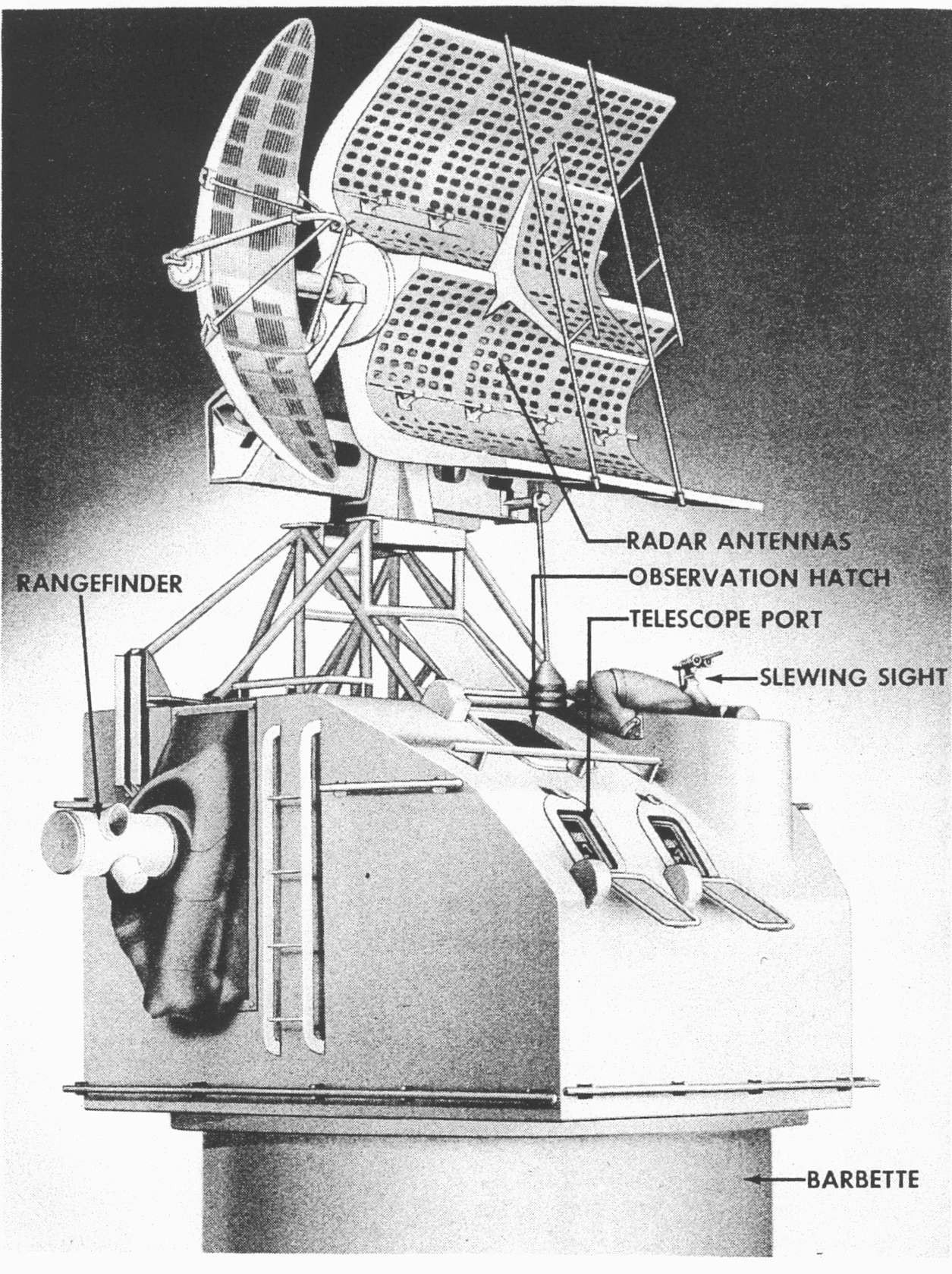 Ship gun fire-control systems (GFCS) are analogue
Ship gun fire-control systems (GFCS) are analogue History of analogue fire control systems
Naval fire control resembles that of ground-based guns, but with no sharp distinction between direct and indirect fire. It is possible to control several same-type guns on a single platform simultaneously, while both the firing guns and the target are moving. Though a ship rolls and pitches at a slower rate than a tank does, gyroscopic stabilization is extremely desirable. Naval gun fire control potentially involves three levels of complexity: * Local control originated with primitive gun installations aimed by the individual gun crews. * The director system of fire control was incorporated first into battleship designs by the Royal Navy in 1912. All guns on a single ship were laid from a central position placed as high as possible above the bridge. The director became a design feature ofPre- dreadnought control system
The Royal Navy was aware of the fall of shot observation advantage of salvo firing through several experiments as early as 1870 when Commander John A. Fisher installed an electric system enabling a simultaneous firing of all the guns to HMS ''Ocean'', the flagship of the China Station as the second in command. However, the Station or Royal Navy had not yet implemented the system fleet-wide in 1904. The Royal Navy considered Russia a potential adversary through The Great Game, and sent LieutenantCentral fire control and World War I
Centralized naval fire control systems were first developed around the time of World War I. Local control had been used up until that time, and remained in use on smaller warships and auxiliaries through World War II. Specifications of were finalized after the report on theAnalogue computed fire control
Unmeasured and uncontrollable ballistic factors like high altitude temperature, humidity, barometric pressure, wind direction and velocity required final adjustment through observation of fall of shot. Visual range measurement (of both target and shell splashes) was difficult prior to availability of radar. The British favoured coincidence rangefinders while the Germans and the US Navy, stereoscopic type. The former were less able to range on an indistinct target but easier on the operator over a long period of use, the latter the reverse. During theRadar and World War II
During their long service life, rangekeepers were updated often as technology advanced and by World War II they were a critical part of an integrated fire control system. The incorporation of radar into the fire control system early in World War II provided ships with the ability to conduct effective gunfire operations at long range in poor weather and at night. In a typical World War II British ship the fire control system connected the individual gun turrets to the director tower (where the sighting instruments were) and the analogue computer in the heart of the ship. In the director tower, operators trained their telescopes on the target; one telescope measured elevation and the other bearing. Rangefinder telescopes on a separate mounting measured the distance to the target. These measurements were converted by the Fire Control Table into bearings and elevations for the guns to fire on. In the turrets, the gunlayers adjusted the elevation of their guns to match an indicator which was the elevation transmitted from the Fire Control Table—a turret layer did the same for bearing. When the guns were on target they were centrally fired. The Aichi Clock Company first produced the Type 92 ''Shagekiban'' low angle analog computer in 1932. The US Navy Rangekeeper and the Mark 38 GFCS had an edge over Imperial Japanese Navy systems in operability and flexibility. The US system allowing the plotting room team to quickly identify target motion changes and apply appropriate corrections. The newer Japanese systems such as the Type 98 ''Hoiban'' and ''Shagekiban'' on the were more up to date, which eliminated the ''Sokutekiban'', but it still relied on seven operators. In contrast to US radar aided system, the Japanese relied on averaging optical rangefinders, lacked gyros to sense the horizon, and required manual handling of follow-ups on the ''Sokutekiban'','' Shagekiban'', ''Hoiban'' as well as guns themselves. This could have played a role in Center Force's battleships' dismal performance in the Battle off Samar in October 1944. In that action, American destroyers pitted against the world's largest armored battleships and cruisers dodged shells for long enough to close to within torpedo firing range, while lobbing hundreds of accurate automatically aimed rounds on target. Cruisers did not land hits on splash-chasing escort carriers until after an hour of pursuit had reduced the range to . Although the Japanese pursued a doctrine of achieving superiority at long gun ranges, one cruiser fell victim to secondary explosions caused by hits from the carriers' single 5-inch guns. Eventually with the aid of hundreds of carrier based aircraft, a battered Center Force was turned back just before it could have finished off survivors of the lightly armed task force of screening escorts and escort carriers of Taffy 3. The earlier Battle of Surigao Strait had established the clear superiority of US radar-assisted systems at night. The rangekeeper's target position prediction characteristics could be used to defeat the rangekeeper. For example, many captains under long range gun attack would make violent maneuvers to "chase salvos." A ship that is chasing salvos is maneuvering to the position of the last salvo splashes. Because the rangekeepers are constantly predicting new positions for the target, it is unlikely that subsequent salvos will strike the position of the previous salvo. The direction of the turn is unimportant, as long as it is not predicted by the enemy system. Since the aim of the next salvo depends on observation of the position and speed at the time the previous salvo hits, that is the optimal time to change direction. Practical rangekeepers had to assume that targets were moving in a straight-line path at a constant speed, to keep complexity to acceptable limits. A sonar rangekeeper was built to include a target circling at a constant radius of turn, but that function had been disabled. Only the RN and USN achieved 'blindfire' radar fire-control, with no need to visually acquire the opposing vessel. The Axis powers all lacked this capability. Classes such as ''Iowa'' and ''South Dakota'' battleships could lob shells over visual horizon, in darkness, through smoke or weather. American systems, in common with many contemporary major navies, had gyroscopic stable vertical elements, so they could keep a solution on a target even during maneuvers. By the start of World War II British, German and American warships could both shoot and maneuver using sophisticated analog fire-control computers that incorporated gyro compass and gyro Level inputs. In the Battle of Cape Matapan the BritishBritish Royal Navy systems
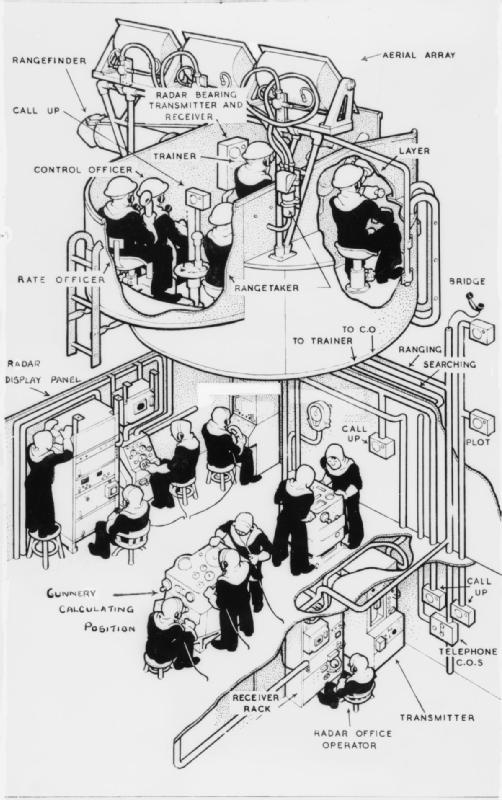 * Dreyer Table
* Arthur Pollen's Argo Clock
* Admiralty Fire Control Table – from 1920s
* HACS – A/A system from 1931
* Fuze Keeping Clock – simplified HACS A/A system for destroyers from 1938
* Pom-Pom Director – pioneered use of gyroscopic tachymetric fire-control for short range weapons – From 1940
* Gyro Rate Unit – pioneered use of gyroscopic Tachymetric fire-control for medium calibre weapons – From 1940
* Royal Navy radar – pioneered the use of radar for A/A fire-control and centimetric radar for surface fire-control – from 1939
* Ferranti Computer Systems developed the GSA4 digital computerised gunnery fire control system that was deployed on HMS Amazon (Type 21 frigate commissioned in 1974) as part of the WAS4 (Weapon Systems Automation - 4) system.
* BAE Systems' Sea Archer – computerised gunnery system. Royal Navy designation GSA.7 from 1980 and GSA.8 from 1985. Production was completed for Royal Navy Type 23 frigates in 1999. Remains in active service on Type 23 (''Duke'' class). Replaced in 2012 on Type 45 destroyers by Ultra Electronics Series 2500 Electro-Optical Gun Control System.
* Dreyer Table
* Arthur Pollen's Argo Clock
* Admiralty Fire Control Table – from 1920s
* HACS – A/A system from 1931
* Fuze Keeping Clock – simplified HACS A/A system for destroyers from 1938
* Pom-Pom Director – pioneered use of gyroscopic tachymetric fire-control for short range weapons – From 1940
* Gyro Rate Unit – pioneered use of gyroscopic Tachymetric fire-control for medium calibre weapons – From 1940
* Royal Navy radar – pioneered the use of radar for A/A fire-control and centimetric radar for surface fire-control – from 1939
* Ferranti Computer Systems developed the GSA4 digital computerised gunnery fire control system that was deployed on HMS Amazon (Type 21 frigate commissioned in 1974) as part of the WAS4 (Weapon Systems Automation - 4) system.
* BAE Systems' Sea Archer – computerised gunnery system. Royal Navy designation GSA.7 from 1980 and GSA.8 from 1985. Production was completed for Royal Navy Type 23 frigates in 1999. Remains in active service on Type 23 (''Duke'' class). Replaced in 2012 on Type 45 destroyers by Ultra Electronics Series 2500 Electro-Optical Gun Control System.
US Navy analogue Gun Fire Control Systems (GFCS)
Mark 33 GFCS
The Mark 33 GFCS was a power-driven fire control director, less advanced than the Mark 37. The Mark 33 GFCS used a Mark 10 Rangekeeper, analog fire-control computer. The entire rangekeeper was mounted in an open director rather than in a separate plotting room as in the RN HACS, or the later Mark 37 GFCS, and this made it difficult to upgrade the Mark 33 GFCS.Campbell, ''Naval Weapons of WW2'' It could compute firing solutions for targets moving at up to 320 knots, or 400 knots in a dive. Its installations started in the late 1930s on destroyers, cruisers and aircraft carriers with two Mark 33 directors mounted fore and aft of the island. They had no fire-control radar initially, and were aimed only by sight. After 1942, some of these directors were enclosed and had a Mark 4 fire-control radar added to the roof of the director, while others had a Mark 4 radar added over the open director. With the Mark 4 large aircraft at up to 40,000 yards could be targeted. It had less range against low-flying aircraft, and large surface ships had to be within 30,000 yards. With radar, targets could be seen and hit accurately at night, and through weather. The Mark 33 and 37 systems used tachymetric target motion prediction. The USN never considered the Mark 33 to be a satisfactory system, but wartime production problems, and the added weight and space requirements of the Mark 37 precluded phasing out the Mark 33: The Mark 33 was used as the main director on some destroyers and as secondary battery / anti-aircraft director on larger ships (i.e. in the same role as the later Mark 37). The guns controlled by it were typically 5 inch weapons: the 5-inch/25 or 5-inch/38.Deployment
* destroyers (1 per vessel, total 48) ** 8 (launched ca. 1934) ** 18 (ca. 1935) (, later rebuilt with Mk37) ** 4 (ca. 1937) ** 8 (ca. 1937) ** 10 (ca. 1938) * heavy cruisers ** 7 (launched ca. 1933): for the 5"/25 secondary battery ** (1937): for the 5"/38 secondary battery * light cruisers ** 9 (launched ca. 1937): for the 5"/25 and 5"/38 secondary batteriesMark 34 GFCS
The Mark 34 was used to control the main batteries of large gun ships. Its predecessors include Mk18 (), Mk24 (), Mk27 () and Mk31 ()Stille 2014, Pre-war cruisersDeployment
* 2 large cruisers (2 per vessel) * heavy cruisers ** (2x) ** 14 (2 per vessel, 28 total) ** several (as upgrade) ** (as upgrade) * light cruisers ** 9 ** 27Mark 37 GFCS
According to the US Navy Bureau of Ordinance,While the defects were not prohibitive and the Mark 33 remained in production until fairly late in World War II, the Bureau started the development of an improved director in 1936, only 2 years after the first installation of a Mark 33. The objective of weight reduction was not met, since the resulting director system actually weighed about more than the equipment it was slated to replace, but the Gun Director Mark 37 that emerged from the program possessed virtues that more than compensated for its extra weight. Though the gun orders it provided were the same as those of the Mark 33, it supplied them with greater reliability and gave generally improved performance with gun batteries, whether they were used for surface or antiaircraft use. Moreover, the stable element and computer, instead of being contained in the director housing were installed below deck where they were less vulnerable to attack and less of a jeopardy to a ship's stability. The design provided for the ultimate addition of radar, which later permitted blind firing with the director. In fact, the Mark 37 system was almost continually improved. By the end of 1945 the equipment had run through 92 modifications—almost twice the total number of directors of that type which were in the fleet on December 7, 1941. Procurement ultimately totalled 841 units, representing an investment of well over $148,000,000. Destroyers, cruisers, battleships, carriers, and many auxiliaries used the directors, with individual installations varying from one aboard destroyers to four on each battleship. The development of the Gun Directors Mark 33 and 37 provided the United States Fleet with good long range fire control against attacking planes. But while that had seemed the most pressing problem at the time the equipments were placed under development, it was but one part of the total problem of air defense. At close-in ranges the accuracy of the directors fell off sharply; even at intermediate ranges they left much to be desired. The weight and size of the equipments militated against rapid movement, making them difficult to shift from one target to another.Their efficiency was thus in inverse proportion to the proximity of danger.The computer was completed as the Ford Mark 1 computer by 1935. Rate information for height changes enabled complete solution for aircraft targets moving over . Destroyers starting with the employed one of these computers, battleships up to four. The system's effectiveness against aircraft diminished as planes became faster, but toward the end of World War II upgrades were made to the Mark 37 System, and it was made compatible with the development of the VT (Variable Time)
Mark 37 Director
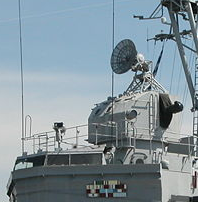 The function of the Mark 37 Director, which resembles a turret with "ears" rather than guns, was to track the present position of the target in bearing, elevation, and range. To do this, it had optical sights (the rectangular windows or hatches on the front), an optical rangefinder (the tubes or ears sticking out each side), and later models, fire control radar antennas. The rectangular antenna is for the Mark 12 FC radar, and the parabolic antenna on the left ("orange peel") is for the Mark 22 FC radar. They were part of an upgrade to improve tracking of aircraft.
The director was manned by a crew of 6: Director Officer, Assistant Control Officer, Pointer, Trainer, Range Finder Operator and Radar Operator.https://www.okieboat.com/Gun%20Director.html
The Director Officer also had a slew sight used to quickly point the director towards a new target. Up to four Mark 37 Gun Fire Control Systems were installed on battleships. On a battleship, the director was protected by of armor, and weighs 21 tons. The Mark 37 director aboard is protected with of armor plate and weighs 16 tons.
The function of the Mark 37 Director, which resembles a turret with "ears" rather than guns, was to track the present position of the target in bearing, elevation, and range. To do this, it had optical sights (the rectangular windows or hatches on the front), an optical rangefinder (the tubes or ears sticking out each side), and later models, fire control radar antennas. The rectangular antenna is for the Mark 12 FC radar, and the parabolic antenna on the left ("orange peel") is for the Mark 22 FC radar. They were part of an upgrade to improve tracking of aircraft.
The director was manned by a crew of 6: Director Officer, Assistant Control Officer, Pointer, Trainer, Range Finder Operator and Radar Operator.https://www.okieboat.com/Gun%20Director.html
The Director Officer also had a slew sight used to quickly point the director towards a new target. Up to four Mark 37 Gun Fire Control Systems were installed on battleships. On a battleship, the director was protected by of armor, and weighs 21 tons. The Mark 37 director aboard is protected with of armor plate and weighs 16 tons.
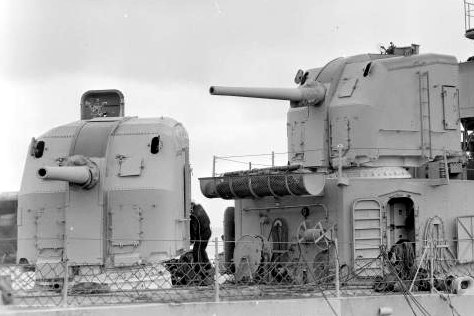 Stabilizing signals from the Stable Element kept the optical sight telescopes, rangefinder, and radar antenna free from the effects of deck tilt. The signal that kept the rangefinder's axis horizontal was called "crosslevel"; elevation stabilization was called simply "level". Although the stable element was below decks in Plot, next to the Mark 1/1A computer, its internal gimbals followed director motion in bearing and elevation so that it provided level and crosslevel data directly. To do so, accurately, when the fire control system was initially installed, a surveyor, working in several stages, transferred the position of the gun director into Plot so the stable element's own internal mechanism was properly aligned to the director.
Although the rangefinder had significant mass and inertia, the crosslevel servo normally was only lightly loaded, because the rangefinder's own inertia kept it essentially horizontal; the servo's task was usually simply to ensure that the rangefinder and sight telescopes remained horizontal.
Mark 37 director train (bearing) and elevation drives were by D.C. motors fed from Amplidyne rotary power-amplifying generators. Although the train Amplidyne was rated at several kilowatts maximum output, its input signal came from a pair of 6L6 audio beam tetrode vacuum tubes (valves, in the U.K.).
Stabilizing signals from the Stable Element kept the optical sight telescopes, rangefinder, and radar antenna free from the effects of deck tilt. The signal that kept the rangefinder's axis horizontal was called "crosslevel"; elevation stabilization was called simply "level". Although the stable element was below decks in Plot, next to the Mark 1/1A computer, its internal gimbals followed director motion in bearing and elevation so that it provided level and crosslevel data directly. To do so, accurately, when the fire control system was initially installed, a surveyor, working in several stages, transferred the position of the gun director into Plot so the stable element's own internal mechanism was properly aligned to the director.
Although the rangefinder had significant mass and inertia, the crosslevel servo normally was only lightly loaded, because the rangefinder's own inertia kept it essentially horizontal; the servo's task was usually simply to ensure that the rangefinder and sight telescopes remained horizontal.
Mark 37 director train (bearing) and elevation drives were by D.C. motors fed from Amplidyne rotary power-amplifying generators. Although the train Amplidyne was rated at several kilowatts maximum output, its input signal came from a pair of 6L6 audio beam tetrode vacuum tubes (valves, in the U.K.).
Plotting room
In battleships, the Secondary Battery Plotting Rooms were down below the waterline and inside the armor belt. They contained four complete sets of the fire control equipment needed to aim and shoot at four targets. Each set included a Mark 1A computer, a Mark 6 Stable Element, FC radar controls and displays, parallax correctors, a switchboard, and people to operate it all. (In the early 20th century, successive range and/or bearing readings were probably plotted either by hand or by the fire control devices (or both). Humans were very good data filters, able to plot a useful trend line given somewhat-inconsistent readings. As well, the Mark 8 Rangekeeper included a plotter. The distinctive name for the fire-control equipment room took root, and persisted even when there were no plotters.)Ford Mark 1A Fire Control Computer
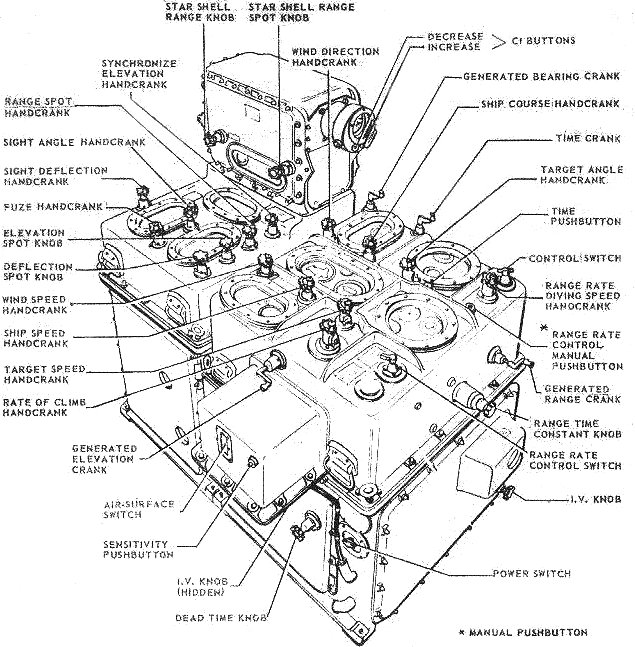 The Mark 1A Fire Control Computer was an electro-mechanical analog ballistic computer. Originally designated the Mark 1, design modifications were extensive enough to change it to "Mark 1A". The Mark 1A appeared post World War II and may have incorporated technology developed for the Bell Labs
The Mark 1A Fire Control Computer was an electro-mechanical analog ballistic computer. Originally designated the Mark 1, design modifications were extensive enough to change it to "Mark 1A". The Mark 1A appeared post World War II and may have incorporated technology developed for the Bell Labs OP 1140
There are photographs of the computer's interior in the National Archives; some are on Web pages, and some of those have been rotated a quarter turn.
Stable Element
The function of the Mark 6 Stable Element (''pictured'') in this fire control system is the same as the function of the Mark 41 Stable Vertical in the main battery system. It is a vertical seeking gyroscope ("vertical gyro", in today's terms) that supplies the system with a stable up direction on a rolling and pitching ship. In surface mode, it replaces the director's elevation signal. It also has the surface mode firing keys. It is based on a gyroscope that erects so its spin axis is vertical. The housing for the gyro rotor rotates at a low speed, on the order of 18 rpm. On opposite sides of the housing are two small tanks, partially filled with mercury, and connected by a capillary tube. Mercury flows to the lower tank, but slowly (several seconds) because of the tube's restriction. If the gyro's spin axis is not vertical, the added weight in the lower tank would pull the housing over if it were not for the gyro and the housing's rotation. That rotational speed and rate of mercury flow combine to put the heavier tank in the best position to make the gyro precess toward the vertical. When the ship changes course rapidly at speed, the acceleration due to the turn can be enough to confuse the gyro and make it deviate from true vertical. In such cases, the ship's gyrocompass sends a disabling signal that closes a solenoid valve to block mercury flow between the tanks. The gyro's drift is low enough not to matter for short periods of time; when the ship resumes more typical cruising, the erecting system corrects for any error. The Earth's rotation is fast enough to need correcting. A small adjustable weight on a threaded rod, and a latitude scale makes the gyro precess at the Earth's equivalent angular rate at the given latitude. The weight, its scale, and frame are mounted on the shaft of a synchro torque receiver fed with ship's course data from the gyro compass, and compensated by a differential synchro driven by the housing-rotator motor. The little compensator in operation is geographically oriented, so the support rod for the weight points east and west. At the top of the gyro assembly, above the compensator, right on center, is an exciter coil fed with low-voltage AC. Above that is a shallow black-painted wooden bowl, inverted. Inlaid in its surface, in grooves, are two coils essentially like two figure 8s, but shaped more like a letter D and its mirror image, forming a circle with a diametral crossover. One coil is displaced by 90 degrees. If the bowl (called an "umbrella") is not centered above the exciter coil, either or both coils have an output that represents the offset. This voltage is phase-detected and amplified to drive two DC servo motors to position the umbrella in line with the coil. The umbrella support gimbals rotate in bearing with the gun director, and the servo motors generate level and crosslevel stabilizing signals. The Mark 1A's director bearing receiver servo drives the pickoff gimbal frame in the stable element through a shaft between the two devices, and the Stable Element's level and crosslevel servos feed those signals back to the computer via two more shafts. (The sonar fire-control computer aboard some destroyers of the late 1950s required roll and pitch signals for stabilizing, so a coordinate converter containing synchros, resolvers, and servos calculated the latter from gun director bearing, level, and crosslevel.)Fire Control Radar
TheDeployment
* destroyers (1 per vessel, 456 total) ** 2 rebuilt : , ** several modernized : , , ** 12 (launched ca. 1939) ** 30 (1939 - 1942) ** 66 (1940 - 1942) ** 175 (1942 - 1944) ** 58 (ca. 1944) ** 12 (ca. 1944) ** 98 (ca. 1945) *** possibly on and which were launched incomplete and never commissioned * light cruisers (62 total) ** TBD: Atlanta, Fargo classes ** 3 (ca. 1945) (2 per vessel, 6 total) ** 27 (launched ca. 1942 - 1945) (2 per vessel, 54 total) *** one Mk37 removed on during CLG conversion ** 2 (ca. 1947) (4 per vessel, 8 total) * heavy cruisers (46 total) ** 14 (ca. 1942 - 1945) (2 per vessel, 28 total)Friedman, U.S. Cruisers p. 480 ** 3 (ca. 1945) (2 per vessel, 6 total) ** 3 (ca. 1947) (4 per vessel, 12 total) * 2 large cruisers (ca. 1943) (2 per vessel, 4 total) * aircraft carriers (2 total) ** TBD: Yorktown, Essex classes, Midway(?) ** : 2xMk37 refitted by May 1942 * battleships (16 total) ** TBD: North Carolina, South Dakota classes, all the old ones that were upgraded with 5in/38(?) ** 4 (launched ca. 1942 - 1943) (4 per vessel)Mark 38 GFCS
The Mark 38 Gun Fire Control System (GFCS) controlled the large main battery guns of ''Iowa''-class battleships. The radar systems used by the Mark 38 GFCS were far more advanced than the primitive radar sets used by the Japanese in World War II. The major components were the director, plotting room, and interconnecting data transmission equipment. The two systems, forward and aft, were complete and independent. Their plotting rooms were isolated to protect against battle damage propagating from one to the other.Director
The forward Mark 38 Director (''pictured'') was situated on top of the fire control tower. The director was equipped with optical sights, optical Mark 48 Rangefinder (the long thin boxes sticking out each side), and a Mark 13 Fire Control Radar antenna (the rectangular shape sitting on top). The purpose of the director was to track the target's present bearing and range. This could be done optically with the men inside using the sights and Rangefinder, or electronically with the radar. (The fire control radar was the preferred method.) The present position of the target was called the Line-Of-Sight (LOS), and it was continuously sent down to the plotting room by synchro motors. When not using the radar's display to determine Spots, the director was the optical spotting station.Plotting room
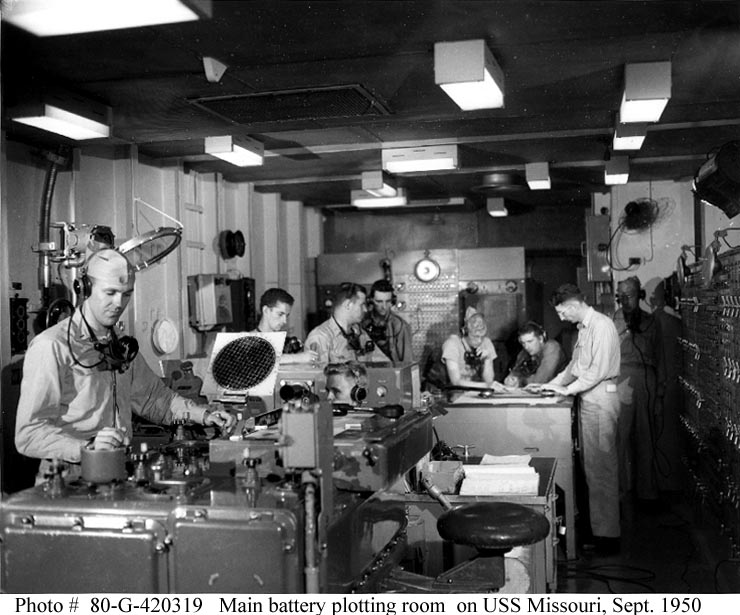 The Forward Main Battery Plotting Room was located below the waterline and inside the armored belt. It housed the forward system's Mark 8 Rangekeeper, Mark 41 Stable Vertical, Mark 13 FC Radar controls and displays,
The Forward Main Battery Plotting Room was located below the waterline and inside the armored belt. It housed the forward system's Mark 8 Rangekeeper, Mark 41 Stable Vertical, Mark 13 FC Radar controls and displays, 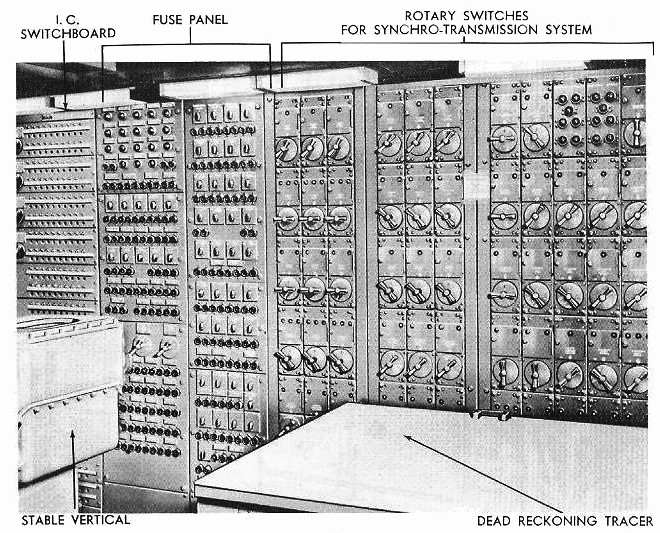 The fire control switchboard configured the battery. With it, the Gunnery Officer could mix and match the three turrets to the two GFCSs. He could have the turrets all controlled by the forward system, all controlled by the aft system, or split the battery to shoot at two targets.
The assistant Gunnery Officers and Fire Control Technicians operated the equipment, talked to the turrets and ship's command by
The fire control switchboard configured the battery. With it, the Gunnery Officer could mix and match the three turrets to the two GFCSs. He could have the turrets all controlled by the forward system, all controlled by the aft system, or split the battery to shoot at two targets.
The assistant Gunnery Officers and Fire Control Technicians operated the equipment, talked to the turrets and ship's command by Mark 51 Fire Control System
 The Bofors 40 mm anti-aircraft guns were arguably the best light anti-aircraft weapon of World War II., employed on almost every major warship in the U.S. and UK fleet during World War II from about 1943 to 1945. They were most effective on ships as large as destroyer escorts or larger when coupled with electric-hydraulic drives for greater speed and the Mark 51 Director (''pictured'') for improved accuracy, the Bofors 40 mm gun became a fearsome adversary, accounting for roughly half of all Japanese aircraft shot down between 1 October 1944 and 1 February 1945.
The Bofors 40 mm anti-aircraft guns were arguably the best light anti-aircraft weapon of World War II., employed on almost every major warship in the U.S. and UK fleet during World War II from about 1943 to 1945. They were most effective on ships as large as destroyer escorts or larger when coupled with electric-hydraulic drives for greater speed and the Mark 51 Director (''pictured'') for improved accuracy, the Bofors 40 mm gun became a fearsome adversary, accounting for roughly half of all Japanese aircraft shot down between 1 October 1944 and 1 February 1945.
Mark 56 GFCS
This GFCS was an intermediate-range, anti-aircraft gun fire-control system. It was designed for use against high-speed subsonic aircraft. It could also be used against surface targets. It was a dual ballistic system. This means that it was capable of simultaneously producing gun orders for two different gun types (e.g.: 5"/38cal and 3"/50cal) against the same target. Its Mark 35 Radar was capable of automatic tracking in bearing, elevation, and range that was as accurate as any optical tracking. The whole system could be controlled from the below decks Plotting Room with or without the director being manned. This allowed for rapid target acquisition when a target was first detected and designated by the ship's air-search radar, and not yet visible from on deck. Its target solution time was less than 2 seconds after Mark 35 radar "Lock on". It was designed toward the end of World War II, apparently in response to Japanese kamikaze aircraft attacks. It was conceived by Ivan Getting, mentioned near the end of hiOral history
and its linkage computer was designed by Antonín Svoboda. Its gun director was not shaped like a box, and it had no optical rangefinder. The system was manned by crew of four. On the left side of the director, was the Cockpit where the Control Officer stood behind the sitting Director Operator (Also called Director Pointer). Below decks in Plot, was the Mark 4 Radar Console where the Radar Operator and Radar Tracker sat. The director's movement in bearing was unlimited because it had slip-rings in its pedestal. (The Mark 37 gun director had a cable connection to the hull, and occasionally had to be "unwound".) Fig. 26E8 o
this
Web page shows the director in considerable detail. The explanatory drawings of the system show how it works, but are wildly different in physical appearance from the actual internal mechanisms, perhaps intentionally so. However, it omits any significant description of the mechanism of the linkage computer
That chapter
is an excellent detailed reference that explains much of the system's design, which is quite ingenious and forward-thinking in several respects. In the 1968 upgrade to for service off Vietnam, three Mark 56 Gun Fire Control Systems were installed. Two on either side just forward of the aft stack, and one between the aft mast and the aft Mark 38 Director tower. This increased ''New Jerseys anti-aircraft capability, because the Mark 56 system could track and shoot at faster planes.
Mark 63 GFCS
The Mark 63 was introduced in 1953 for the twin QF 4-inch naval gun Mk XVI and Mk.33 twin 3"/50 cal guns. The GFCS consists of an AN/SPG-34 radar tracker and a Mark 29 gun sight.Mark 68 GFCS
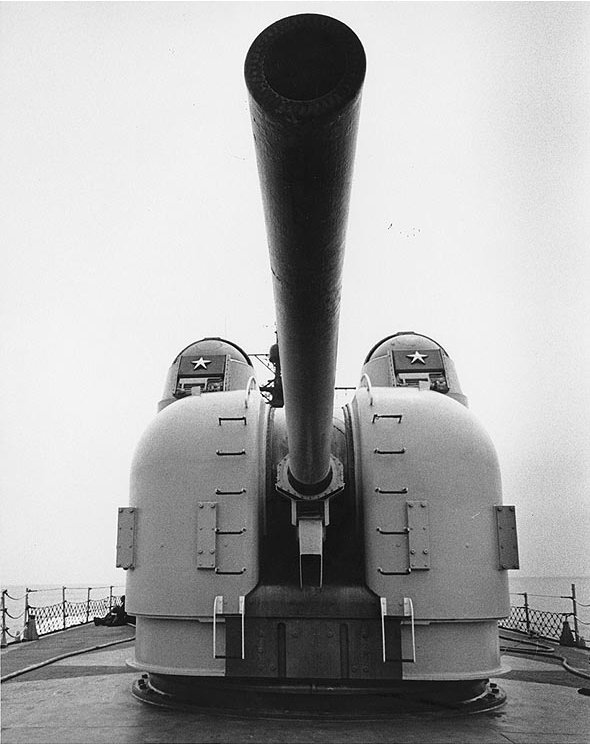 Introduced in the early 1950s, the Mark 68 was an upgrade from the Mark 37 effective against air and surface targets. It combined a manned topside director, a conical scan acquisition and tracking radar, an analog computer to compute ballistics solutions, and a gyro stabilization unit.
The gun director was mounted in a large yoke, and the whole director was stabilized in crosslevel (the yoke's pivot axis). That axis was in a vertical plane that included the line of sight.
At least in 1958, the computer was the Mark 47, an hybrid electronic/electromechanical system. Somewhat akin to the Mark 1A, it had electrical high-precision resolvers instead of the mechanical one of earlier machines, and multiplied with precision linear potentiometers. However, it still had disc/roller integrators as well as shafting to interconnect the mechanical elements. Whereas access to much of the Mark 1A required time-consuming and careful disassembly (think days in some instances, and possibly a week to gain access to deeply buried mechanisms), the Mark 47 was built on thick support plates mounted behind the front panels on slides that permitted its six major sections to be pulled out of its housing for easy access to any of its parts. (The sections, when pulled out, moved fore and aft; they were heavy, not counterbalanced. Typically, a ship rolls through a much larger angle than it pitches.) The Mark 47 probably had 3-D cams for ballistics, but information on it appears very difficult to obtain.
Mechanical connections between major sections were via shafts in the extreme rear, with couplings permitting disconnection without any attention, and probably relief springs to aid re-engagement. One might think that rotating an output shaft by hand in a pulled-out section would misalign the computer, but the type of data transmission of all such shafts did not represent magnitude; only the incremental rotation of such shafts conveyed data, and it was summed by differentials at the receiving end. One such kind of quantity is the output from the roller of a mechanical integrator; the position of the roller at any given time is immaterial; it is only the incrementing and decrementing that counts.
Whereas the Mark 1/1A computations for the stabilizing component of gun orders had to be approximations, they were theoretically exact in the Mark 47 computer, computed by an electrical resolver chain.
The design of the computer was based on a re-thinking of the fire control problem; it was regarded quite differently.
Production of this system lasted for over 25 years. A digital upgrade was available from 1975 to 1985, and it was in service into the 2000s. The digital upgrade was evolved for use in the s.
The AN/SPG-53 was a United States Navy gun
Introduced in the early 1950s, the Mark 68 was an upgrade from the Mark 37 effective against air and surface targets. It combined a manned topside director, a conical scan acquisition and tracking radar, an analog computer to compute ballistics solutions, and a gyro stabilization unit.
The gun director was mounted in a large yoke, and the whole director was stabilized in crosslevel (the yoke's pivot axis). That axis was in a vertical plane that included the line of sight.
At least in 1958, the computer was the Mark 47, an hybrid electronic/electromechanical system. Somewhat akin to the Mark 1A, it had electrical high-precision resolvers instead of the mechanical one of earlier machines, and multiplied with precision linear potentiometers. However, it still had disc/roller integrators as well as shafting to interconnect the mechanical elements. Whereas access to much of the Mark 1A required time-consuming and careful disassembly (think days in some instances, and possibly a week to gain access to deeply buried mechanisms), the Mark 47 was built on thick support plates mounted behind the front panels on slides that permitted its six major sections to be pulled out of its housing for easy access to any of its parts. (The sections, when pulled out, moved fore and aft; they were heavy, not counterbalanced. Typically, a ship rolls through a much larger angle than it pitches.) The Mark 47 probably had 3-D cams for ballistics, but information on it appears very difficult to obtain.
Mechanical connections between major sections were via shafts in the extreme rear, with couplings permitting disconnection without any attention, and probably relief springs to aid re-engagement. One might think that rotating an output shaft by hand in a pulled-out section would misalign the computer, but the type of data transmission of all such shafts did not represent magnitude; only the incremental rotation of such shafts conveyed data, and it was summed by differentials at the receiving end. One such kind of quantity is the output from the roller of a mechanical integrator; the position of the roller at any given time is immaterial; it is only the incrementing and decrementing that counts.
Whereas the Mark 1/1A computations for the stabilizing component of gun orders had to be approximations, they were theoretically exact in the Mark 47 computer, computed by an electrical resolver chain.
The design of the computer was based on a re-thinking of the fire control problem; it was regarded quite differently.
Production of this system lasted for over 25 years. A digital upgrade was available from 1975 to 1985, and it was in service into the 2000s. The digital upgrade was evolved for use in the s.
The AN/SPG-53 was a United States Navy gun US Navy computerized fire control systems
Mark 86 GFCS
 The US Navy desired a digital computerized gun fire-control system in 1961 for more accurate shore bombardment. Lockheed Electronics produced a prototype with AN/SPQ-9 radar fire control in 1965. An air defense requirement delayed production with the AN/SPG-60 until 1971. The Mark 86 did not enter service until when the nuclear-powered missile cruiser was commissioned in February 1974, and subsequently installed on US cruisers and amphibious assault ships. The last US ship to receive the system, was commissioned in July 1994.
The Mark 86 on Aegis-class ships controls the ship's 5"/54 caliber Mark 45 gun mounts, and can engage up to two targets at a time. It also uses a Remote Optical Sighting system which uses a TV camera with a telephoto zoom lens mounted on the mast and each of the illuminating radars.
The US Navy desired a digital computerized gun fire-control system in 1961 for more accurate shore bombardment. Lockheed Electronics produced a prototype with AN/SPQ-9 radar fire control in 1965. An air defense requirement delayed production with the AN/SPG-60 until 1971. The Mark 86 did not enter service until when the nuclear-powered missile cruiser was commissioned in February 1974, and subsequently installed on US cruisers and amphibious assault ships. The last US ship to receive the system, was commissioned in July 1994.
The Mark 86 on Aegis-class ships controls the ship's 5"/54 caliber Mark 45 gun mounts, and can engage up to two targets at a time. It also uses a Remote Optical Sighting system which uses a TV camera with a telephoto zoom lens mounted on the mast and each of the illuminating radars.
Mark 34 Gun Weapon System (GWS)
The Mark 34 Gun Weapon System comes in various versions. It is an integral part of the Aegis combat weapon system on guided missile destroyers and modified s. It combines the Mark 45 5"/54 or 5"/62 Caliber Gun Mount, Mark 46 Optical Sight System or Mark 20 Electro-Optical Sight System and the Mark 160 Mod 4–11 Gunfire Control System / Gun Computer System. Other versions of the Mark 34 GWS are used by foreign navies as well as the US Coast Guard, with each configuration having its own unique camera and/or gun system. It can be used against surface ship and close hostile aircraft, and as in Naval Gunfire Support (NGFS) against shore targets.Mark 92 Fire Control System (FCS)
 The Mark 92 fire control system, an Americanized version of the WM-25 system designed in The Netherlands, was approved for service use in 1975. It is deployed on board the relatively small and austere to control the Mark 75 Naval Gun and the Mark 13 Guided Missile Launching System (missiles have since been removed since retirement of its version of the Standard missile). The Mod 1 system used in PHMs (retired) and the US Coast Guard's WMEC and WHEC ships can track one air or surface target using the monopulse tracker and two surface or shore targets. ''Oliver Hazard Perry''-class frigates with the Mod 2 system can track an additional air or surface target using the Separate Track Illuminating Radar (STIR).
The Mark 92 fire control system, an Americanized version of the WM-25 system designed in The Netherlands, was approved for service use in 1975. It is deployed on board the relatively small and austere to control the Mark 75 Naval Gun and the Mark 13 Guided Missile Launching System (missiles have since been removed since retirement of its version of the Standard missile). The Mod 1 system used in PHMs (retired) and the US Coast Guard's WMEC and WHEC ships can track one air or surface target using the monopulse tracker and two surface or shore targets. ''Oliver Hazard Perry''-class frigates with the Mod 2 system can track an additional air or surface target using the Separate Track Illuminating Radar (STIR).
Mark 160 Gun Computing System
Used in theSee also
* Close-in weapon system * Director (military) *Notes
Citations
Bibliography
* * * * * * * * * * * * * * {{USNAVYExternal links
The British High Angle Control System (HACS)
– Comparison of World War II battleship systems
Appendix one, Classification of Director Instruments
HACS III Operating manual Part 1
HACS III Operating manual Part 2
* ttp://www.navsource.org/archives/01/57o.htm Director section of Mark 1 Mod 1 computer operations at NavSource.org
Naval Ordnance and Gunnery, Vol. 2, Chapter 25, AA Fire Control Systems
Anti-aircraft artillery * Naval weapons of the United States Naval artillery fire control system Artillery operation World War II naval weapons Artillery of the United States Fire-control computers of World War II